As of April 2023, Salesforce controlled over 22% of the global customer relationship management (CRM) market, more than double the share of its mighty rival SAP.
Since its emergence in 1999, Salesforce has been helping businesses save on custom development and hosting, avoid paying for multiple product licenses, and scale operations by offering a flexible and secure cloud-based platform loaded with a slew of powerful business tools that get regular updates.
But despite the commanding position Salesforce holds, various competitors exist that may be better suited (for example) to small businesses looking for a simple CRM to automate their sales process or to large enterprises with specific contact management needs.
In this article, we go over some of the best Salesforce alternatives that you may find to be a better match for your needs.
What makes Salesforce the market leader?
There is a reason why Salesforce has such a dominant market position — it’s one of the most elaborate CRM platforms to ever exist, packing tons of game-changing features that help transform businesses by fueling long-term CRM strategies.
Here at PandaDoc, we also use Salesforce as our CRM software of choice, and we find the platform perfect for our needs.
It’s easy to use and offers features you won’t find in other CRM tools, including task management, workflow creation, opportunity tracking, and even collaboration tools — all within a single user-friendly interface.
In fact, we like Salesforce so much that Salesforce automation was one of the first power features we offered to PandaDoc users — and it remains one of the most popular integrations in our catalog.
Here are just a few examples of what you will be able to pull off with our Salesforce automation software:
- Create deeply personalized documents in record time
- Create, send, and track your documents without leaving Salesforce
- Improve real-time collaboration on documents for your entire team
- Automate routine tasks to save time
- Add products from any of your objects to a pricing table in a document
- Store your documents in a single, centralized cloud storage
- Enjoy advanced data security and compliance with SOC 2, HIPAA, FERPA, and the GDPR
Now, let’s get back to other members of the PandaDoc CRM integrations club.
1. Pipedrive
Pricing (per user per month): from $14.90
Our rating: 4.7/5
G2 rating: 4.2/5
Customer support: 24/7 support, email, chat, support tickets, knowledge base
Free trial: Yes, 14 days
Ease of use: 5/5
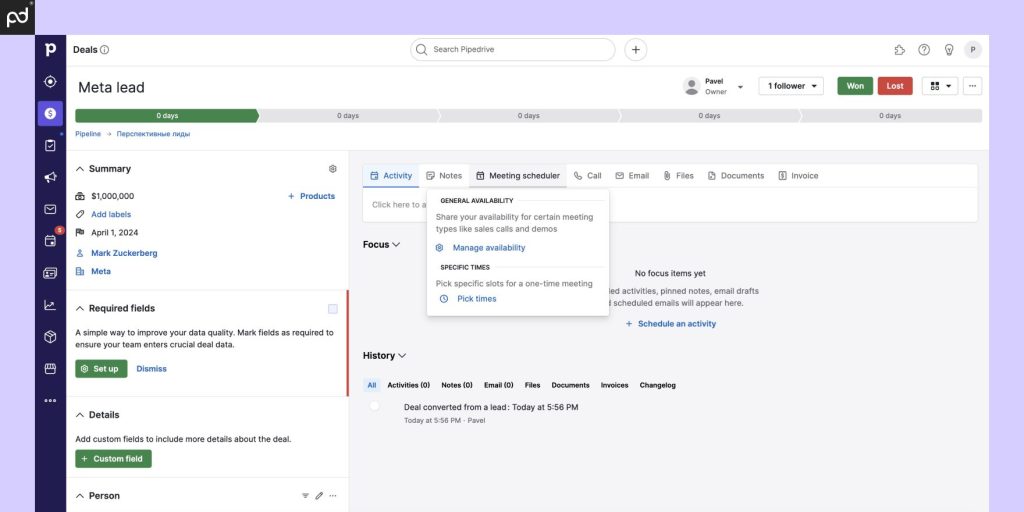
Summary
Pipedrive is a deal-driven CRM system that can also be used for account management and various other business needs.
Not only can it help with marketing and CRM activities; it also acts as sales automation software that can drive the sales process as a whole.
Pipedrive invests heavily in design and ease of use: it provides a simple visual overview of the sales pipeline in the form of a Kanban board.
This ability to visualize the entire sales process and its key metrics, from beginning to end, is a unique feature that may be attractive to small and midsize businesses.
The tool offers advanced capabilities like efficient report generation, lots of integrations, and a lead generation tool with a customizable chatbot called LeadBooster which you can add to your website.
You can also amplify Pipedrive’s CRM capabilities with PandaDoc eSigning and document generation features for end-to-end sales cycle management in a single place.
With this integration, you can:
- Create and open all associated PandaDoc documents from a Pipedrive deal
- Autofill quotes in PandaDoc with data from your Pipedrive CRM records
- Follow document statuses directly from Pipedrive
- Send documents to PandaDoc to collect eSignatures
What makes Pipedrive better than Salesforce?
| Pros | Cons |
|---|---|
| Friendly UI | Limited functionality compared to Salesforce |
| End-to-end coverage of the sales pipeline | May not be suitable for enterprise use |
| Ease of onboarding | |
| Variety of integrations |
2. HubSpot CRM
Pricing (per user per month): Limited free version, commercial editions starting from $15
Our rating: 4.6/5
G2 rating: 4.4/5
Customer support: Email and in-app. Phone support available starting from the Professional plan.
Free trial: Unlimited, Freemium model
Ease of use: 5/5

Summary
Since its emergence in 2006, HubSpot has been a prominent vendor of cutting-edge solutions for:
- sales automation
- sales forecasting
- marketing automation
- social media campaign management
HubSpot has a strong reputation for being an innovator in a number of sales- and marketing-related areas with a strong focus on customer relationship management (CRM).
HubSpot CRM is at the core of each HubSpot edition (or “hub” in the HubSpot language), serving as a single repository of data on clients, deals, interactions, and more.
The lifeblood of HubSpot CRM is its streamlined sales dashboard that shows you things like team activities, deal statuses, performance metrics, and sales forecasts.
This dashboard is also highly customizable, meaning you can add as many elements as you like and remove those that are no longer necessary.
By leveraging PandaDoc integration with HubSpot, you can access any document from a deal, company, or contact record and edit it using PandaDoc templates — all without leaving the HubSpot app.
Those documents can be fully tracked within HubSpot as well.
What makes HubSpot CRM better than Salesforce?
HubSpot CRM can be a great addition to your marketing tech stack if you are new to customer relationship management or already use other HubSpot marketing software.
HubSpot is much easier to set up than Salesforce and can be implemented entirely by your team, with no need for third parties.
The app can also be scaled and customized without introducing more complexity.
| Pros | Cons |
|---|---|
| Comprehensive coverage of the sales process | Onboarding may require time and effort |
| Modern, user-friendly UI | Not the most affordable CRM |
| Ease of deal management | |
| Multiple integrations |
3. Microsoft Dynamics 365
Pricing (per user per month): from $65
Our rating: 4.3/5
G2 rating: 3.8/5
Customer support: Phone and chat, 8 AM to 5 PM Central Time
Free trial: Yes, 30 days
Ease of use: 4.5
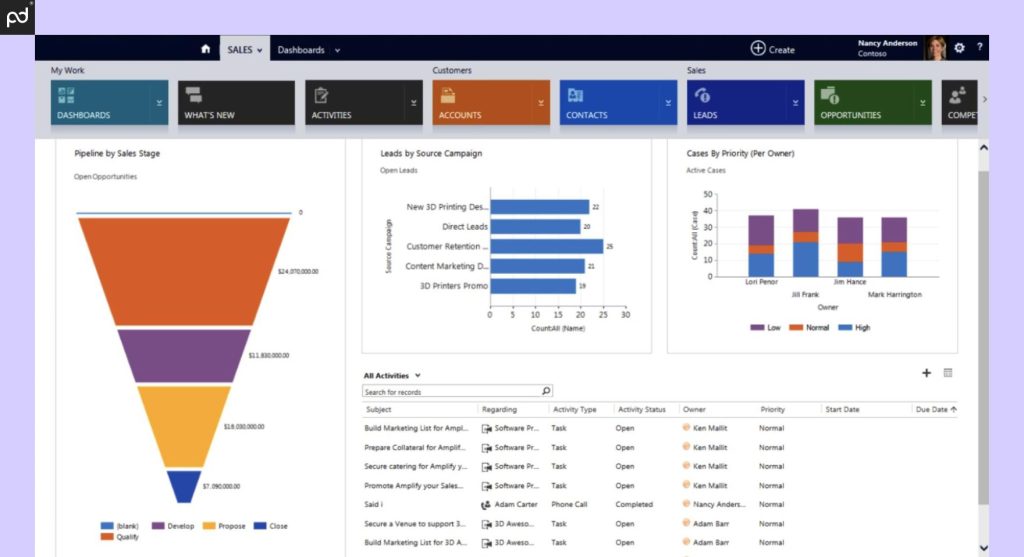
Summary
Microsoft Dynamics 365 is an all-in-one enterprise suite with marketing, finance, operations, and many other capabilities.
Here are some of its most notable advantages:
- Dynamics 365 Sales is focused strongly on CRM functionality with quotes, orders, invoices, and other familiar features.
- Dynamics 365 has the classic Microsoft look and feel, so users familiar with Microsoft Office 365 products and Teams will find the overall experience quite intuitive.
- Dynamics 365 integrates natively with various Microsoft products. For example, you can easily pull data from Excel spreadsheets.
- Dynamics 365 seamlessly integrates with PandaDoc, enabling you to pull key data directly from the app and introduce it into your quotes and proposals.You can also use document analytics to see document creators and managers and to know when your documents are viewed, opened, and signed — all from the convenient Dynamics interface.
What makes Microsoft Dynamics 365 better than Salesforce?
Microsoft Dynamics 365 can be implemented on-premises, which may be important for companies from industries where safety is a special priority.
Many companies rely on private cloud hosting, but some still prefer on-premises server boxes.
The app also integrates quite naturally with other Microsoft business products, so this CRM tool should definitely be your choice if you’re a Microsoft fan.
| Pros | Cons |
|---|---|
| Native integration with MS Office products | Expensive |
| Familiar interface for most users | Potentially overwhelming functionality that may be overkill for SMB users |
| Enterprise-level security | Steep learning curve |
| Variety of hosting options | Complex integration |
| Excellent scalability |
4. Insightly
Pricing (per user per month): Limited free edition, commercial editions starting from $29
Our rating: 4.2/5
G2 rating: 4.4
Customer support: Help center, online chat
Free trial: Yes, 14 days
Ease of use: 4/5
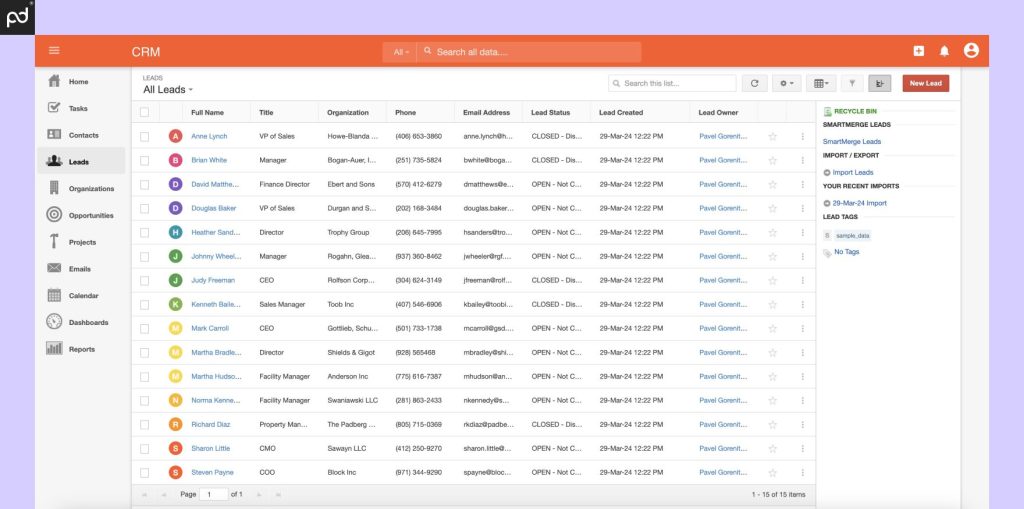
Summary
Insightly CRM is one of the more advanced CRM solutions for small businesses.
It’s a highly intuitive and visually dynamic CRM tool that organizes key CRM functions in an easy-to-understand way and offers a number of powerful features:
- Workflow automation for creating complex processes that span multiple sales phases
- Effortless CRM record management
- Rule-based assignment of opportunities and tasks
- Creation and execution of custom business logic to sync with external systems such as Oracle and SAP
Integrating PandaDoc with Insightly allows sales reps to quickly create detailed proposals from scratch or using PandaDoc templates and then sign documents using legally binding electronic signatures without leaving the Insightly app.
What makes Insightly better than Salesforce?
Insightly is much better suited for small businesses that are looking for a solution without overpowered features.
It’s also more cost-effective and streamlined than Salesforce.
| Pros | Cons |
|---|---|
| Native integration with a variety of MS Office products | Expensive |
| Familiar interface for most users | Potentially overwhelming functionality that may be overkill for SMB users |
| Enterprise-level security | Steep learning curve |
| Variety of hosting options | Complex integration |
5. Monday
Pricing (per user per month): Limited free version, commercial editions starting from $9
Our rating: 4.2/5
G2 rating: 4.7/5
Customer support: Knowledge base, online chat; 24/7 support available with Enterprise plan
Free trial: Yes, 14 days
Ease of use: 4/5
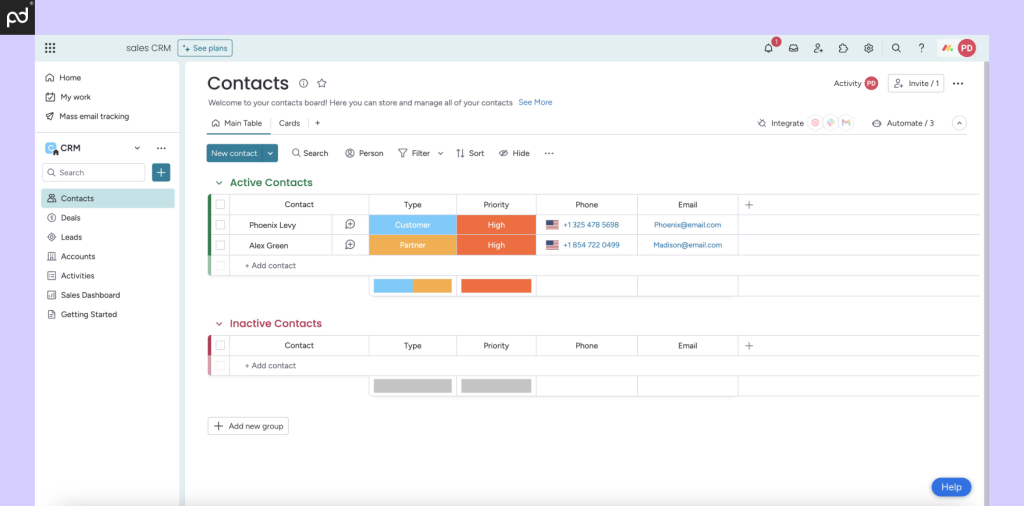
Summary
Monday is a cross between a project management and a customer relationship management tool.
It focuses on providing a visually compelling customer experience with convenient Kanban boards, configurable dashboards, timelines, and other elements that seem to have evolved from basic spreadsheets.
This tool can certainly be adapted to many project-oriented needs, but it also promotes itself as a CRM and sales solution.
However, Monday.com is predominantly project- and team-driven, while other CRM solutions we have reviewed are mostly sales-driven.
Monday.com does offer some basic sales and CRM features, but it is unlikely to be the weapon of choice for your sales team or act as an efficient customer contact center.
What makes Monday.com better than Salesforce?
Monday.com is a viable solution for companies and startups that are looking for basic CRM and lead management functionalities, but it’s hardly an all-encompassing CRM solution.
However, it’s incredibly efficient for task tracking and project management.
| Pros | Cons |
|---|---|
| Overall ease of use | Focus is more on project management than on CRM features |
| Excellent team collaboration tools | Limited functionality |
| Great project and pipeline management capabilities | Relatively weak process automation |
| Sleek, clean UI |
6. Zoho CRM
Pricing (per user per month): From $14
Our rating: 4.1/5
G2 rating: 4.5
Customer support: Help center, email; extra support paid additionally
Free trial: Yes, 30 days
Ease of use: 3.5/5
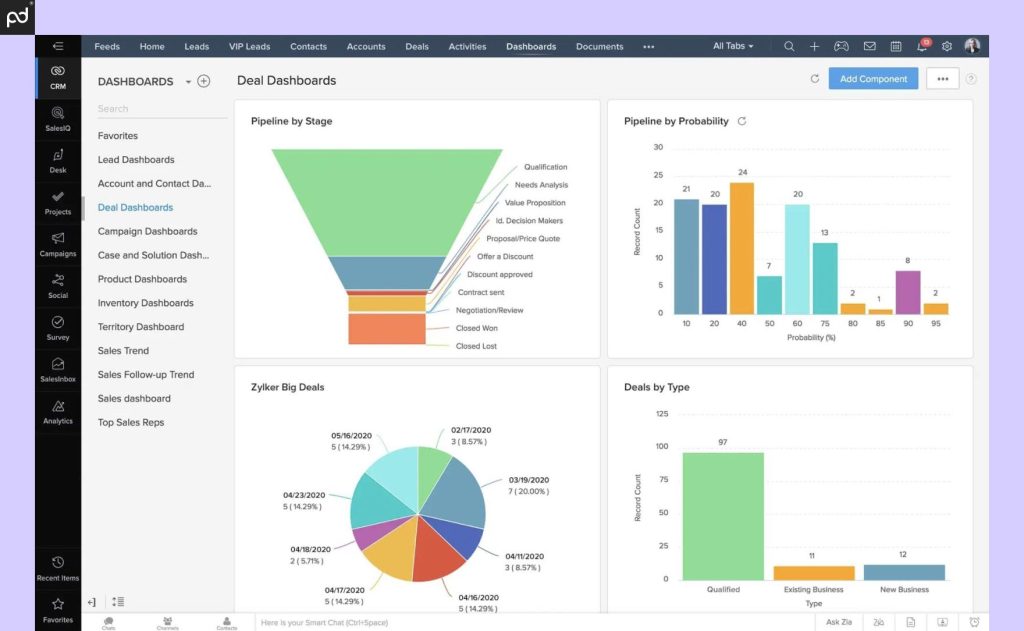
Summary
Zoho is one of the most well-known names in the enterprise software industry, offering more than 40 different tools for businesses.
Much like Salesforce CRM, Zoho’s CRM solution is among the most popular on the market for small to midsize businesses (SMBs).
Zoho CRM is a complex system that requires some customization to make the most out of it.
Creating users, on the other hand, is more straightforward in Zoho CRM compared to Salesforce, and advanced filters make searching for them quite easy.
This software is designed to allow businesses of any size to manage all aspects of customer relationships, from first contact to closing a sale.
What’s obvious when looking at Zoho CRM is that its core functionalities are focused on lead management: capturing and nurturing leads, managing campaigns, prospecting, pipeline tracking, and more.
If you integrate Zoho CRM with PandaDoc, you’ll be able to build interactive pricing tables directly in Zoho CRM and populate your quotes, proposals, and contracts in PandaDoc with accurate data.
You’ll also be able to collaborate on documents by adding approving managers or your legal team and setting the approval order so stakeholders can review documents before they are sent.
What makes Zoho CRM better than Salesforce?
You can automate just about everything with Salesforce if you spend enough money.
However, Zoho CRM is considerably cheaper. It also provides better customer support at lower price points.
| Pros | Cons |
|---|---|
| Comprehensive process automation | Takes a while to fully master |
| Competitive pricing | |
| Remarkable flexibility | |
| Excellent suitability for SMBs |
7. Copper
Pricing (per user per month): From $23
Our rating: 4.1/5
G2 rating: 4.5/5
Customer support: Help center, support requests, contact form
Free trial: Yes, 14 days
Ease of use: 3.5/5
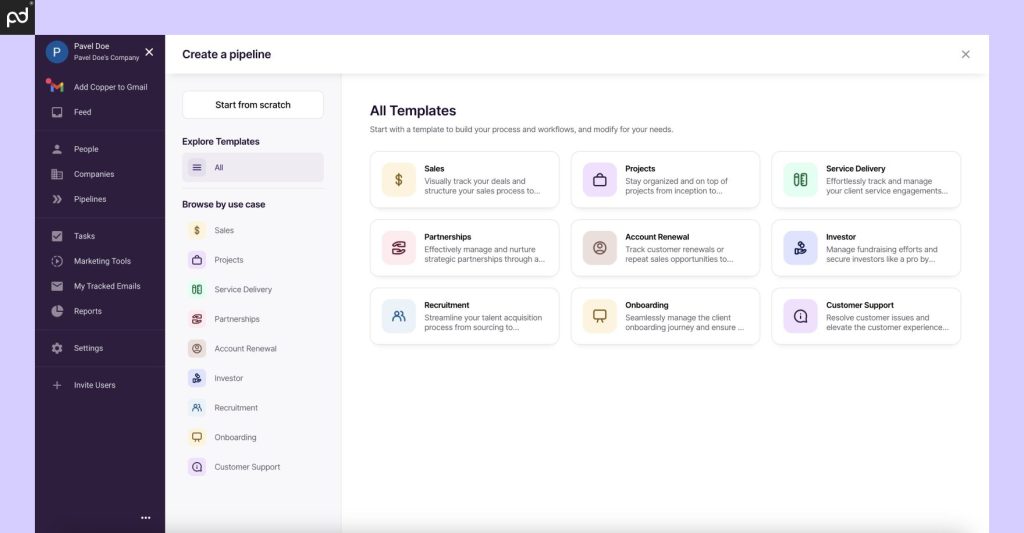
Summary
Copper used to be called G Suite CRM, and you can see that it’s still tied pretty closely to Google’s productivity and marketing tools environment.
It does a fantastic job at combining the simplicity of a Google app with a CRM app that is slightly less feature-rich than some of its competitors.
However, Copper still offers solid lead management capabilities, especially for small businesses and e-commerce shops.
You can actually access Copper right from Gmail in the form of a sidebar that you can hide at any time.
You’ll see pop-ups explaining different Copper features within Gmail the first time you log in.
The Gmail UI focuses on managing contacts, while the Copper web application allows you to dig into opportunities, lead management, and sales pipelines.
You can create custom stages and pipelines that fit your business sales process right from the dashboard.
And if you integrate Copper with PandaDoc, you’ll be able to build impressive proposals right within opportunities and other CRM objects.
You’ll also have the option to track document status updates directly from Copper and see which prospects are ready for follow-ups.
With PandaDoc integration, you’ll have access to any sales document from within your Copper CRM, without having to worry about storage limits.
| Pros | Cons |
|---|---|
| Intuitive UI | Relies on Gmail (Google Workspace) to operate |
| Multiple integrations | Functionality is somewhat limited |
| Ease of use | Limited customization options |
8. Agile CRM
Pricing (per user per month): Limited free version, commercial editions starting from $8.99
Our rating: 4.0/5
G2 rating: 4.0/5
Customer support: Ticket, chat, phone
Free trial: Freemium model
Ease of use: 3.9/5
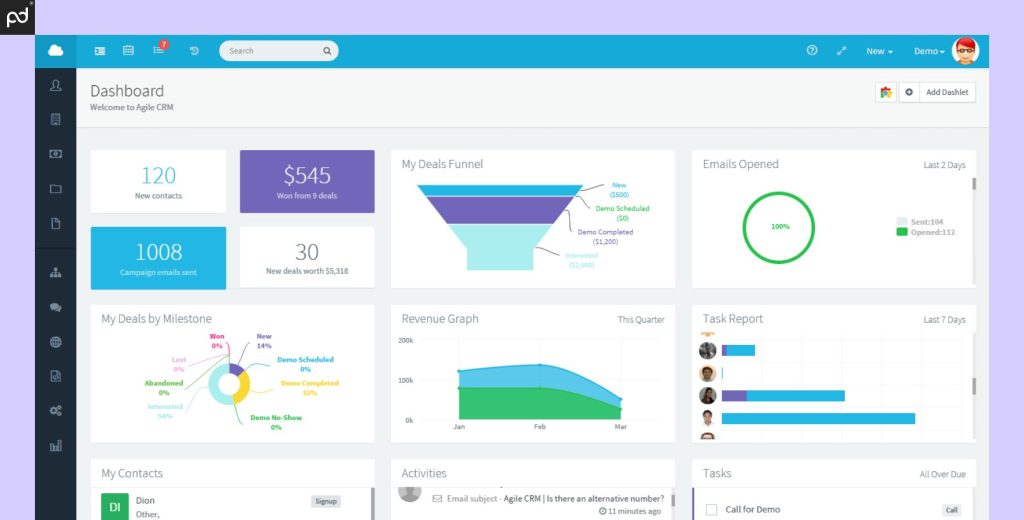
Summary
Every entrepreneur understands how important it is to keep track of contacts.
Agile CRM not only helps you do this but also allows you to get to know your clients better: their preferences, previous interactions with your business, and lots of other information that can make a big difference when closing a sale.
You can use the Deals tool in Agile CRM to forecast future revenue, set goals, and automate follow-ups.
This functionality reduces the need for a large sales staff, and Deals scales effectively as the sales department grows.
Agile CRM also includes a drag-and-drop builder to help your marketing department run more efficiently.
Additionally, handy integration with social media simplifies and streamlines the use of multiple platforms, including X, Facebook, and LinkedIn, allowing you to reach a larger audience.
What makes Agile CRM better than Salesforce?
The Free plan is a welcome sight, especially given that it allows for up to 10 users.
Small companies will find this plan quite useful, and if they want to upgrade to one of the paid plans, $8.99 a month per user isn’t a big price to pay.
While it may lack complex features, Agile CRM is a great simple solution for those looking to save their budget.
| Pros | Cons |
|---|---|
| User-friendly with great support | Somewhat steep learning curve |
| Solid coverage of the sales process | |
| Free plan for small teams |
9. Bitrix 24
Pricing (per company, user count limits apply): Limited free version, commercial editions from $49
Our rating: 4.0/5
G2 rating: 4.1/5
Customer support: Ticket, chat, phone
Free trial: Yes, 30 days (freemium model)
Ease of use: 4.0/5
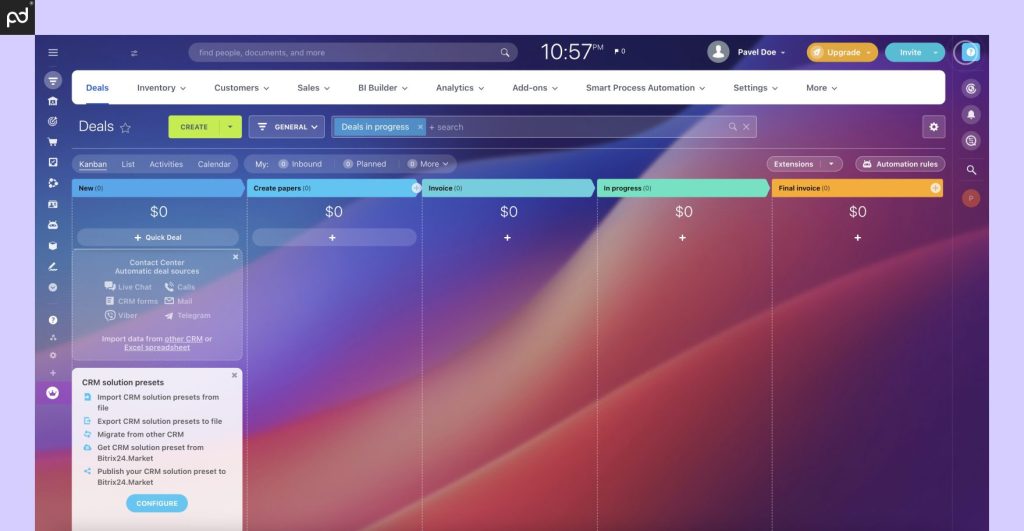
Summary
Small and midsize businesses will find a lot of value in Bitrix24’s basic collaboration, customer relationship management, and lead management features.
When you sign up for the Bitrix24 CRM, you first name your intranet and view your Activity Stream.
This stream is not unlike Facebook — it even allows you to compose a message to share with the rest of your network at the top of the page.
You can easily share files, events, processes, and more with your colleagues. Adding new users to the intranet is also quite easy.
Web-based lead capture forms are another great addition to Bitrix24’s lead management features.
You may use the new web form designer to create a web form by editing an existing CRM form and adding fields like leads, deals, contacts, company, and quotation using the drag-and-drop editing tool.
Why is Bitrix24 better than Salesforce?
Those looking for a low-cost entry into the CRM world will appreciate the fact that Bitrix24 comes with a free plan for an unlimited number of users.
Other plans are charged on a monthly basis, with limits on the maximum number of users (from 5 users in the Basic version to 250 with the Enterprise subscription) but without per-user pricing.
This makes Bitrix24 one of the most affordable CRM solutions, especially for small businesses.
| Pros | Cons |
|---|---|
| Affordable and convenient pricing model | Takes a while to fully master |
| Excellent UI | Not easy to set up |
| Integrated feature set | Excessive functionality for many SMBs |
| Nice collaboration tools |
Other tools to consider
These may be our favorite Salesforce CRM alternatives, but they’re far from the only options on the market.
Here are some other solutions that might fit your needs even better.
- SugarCRM: Packed with features and integrations, SugarCRM is easy to implement in email marketing. It’s also suitable for internal communication.
- Freshworks CRM: Formerly known as Freshsales, this tool has a built-in phone system and extensive calling features. It also features AI-powered lead scoring.
- Oracle NetSuite: One of the pioneers of cloud-based software, NetSuite covers all the basics, including lead management, sales orders and fulfillments, as well as renewals. It also has a built-in e-commerce module.
- SAP Customer Experience: Another big player in the industry, SAP offers an elaborate CRM solution that takes care of data collection, content management, customer retention, and much, much more.
What are the best CRM alternatives to Salesforce?
Salesforce is the market leader when it comes to sales and CRMs, and you’ll hardly find a tool that packs all of the same features in a single platform.
However, we understand that you may not be looking for elaborate features and would rather opt for a simple CRM solution that can save you some money and still get the job done.
If you’re looking for ease of use and an intuitive UI, Pipedrive might be the best alternative to Salesforce.
HubSpot CRM is also up there, and it offers a solid free plan, which can be a big plus if you’re looking to save right now and upgrade as needed.
Other tools have their own advantages, features, and add-ons.
And since most of these tools offer a free trial, you can test things out to be sure you’re making the right decision before you make a financial commitment.
Whichever tool you choose, don’t forget that PandaDoc comes with an impressive array of third-party integrations for automating sales processes that will help you make the most out of your customer relationship efforts.
No matter what CRM tool you end up choosing, PandaDoc will efficiently augment it with a variety of industry-leading, sales-boosting features:
- Hundreds of professional, premade business document templates
- Everything you need for fast, collaborative document management
- Advanced quoting tools
- Powerful document tracking
- Secure, centralized document storage
- Convenient workflow approval
- Integrated eSignature and payments
- And much more!
Explore our pricing plans and book a free demo to see how PandaDoc can address your sales use cases!
How we gathered information on the reviewed CRM systems
The CRM market is doing great and growing at a compound annual growth rate (CAGR 2024–2028) of 10.59%.
It is expected to hit the $88.19B mark in 2024 and reach a whopping US$131.90B by 2028.
With so much money being spent on customer relationship management software, it’s no surprise that the competition in this market segment is fierce.
Smaller CRM vendors do their best to stay abreast of the trends spearheaded by market leaders like Salesforce by rolling out innovative features, offering new perspectives on user experience, or coming up with new ways of accomplishing familiar tasks.
It is with this understanding in mind that we approached this article and evaluated a variety of CRM products.
Our conclusions were drawn from our statistics on CRM integrations across our 50,000+ active users, our own experience with CRM systems, and third-party reviews of covered products from reputable sources:
- Salesforce review from Business.com
- Salesforce user reviews from TrustRadius
- HubSpot CRM review from PCMag
- Microsoft Dynamics reviews from Gartner
- Monday.com reviews from Softwareadvice
We also checked out the websites of the featured CRMs for up-to-date information on their pricing plans, user interfaces, and other details.
For Salesforce alternatives that PandaDoc integrates with, our own researchers investigated such aspects as user-friendliness for new CRM users, ease of workflow creation and configuration, and suitability for SMBs, then incorporated their findings into our product summaries.
Finally, we looked at users’ feedback in online communities, forums, and social networks to capture the voice of the people who actually use these CRMs.
Disclaimer
PandaDoc is not a law firm, or a substitute for an attorney or law firm. This page is not intended to and does not provide legal advice. Should you have legal questions on the validity of e-signatures or digital signatures and the enforceability thereof, please consult with an attorney or law firm. Use of PandaDoc services are governed by our Terms of Use and Privacy Policy.
Originally published October 26, 2021, updated September 5, 2024

